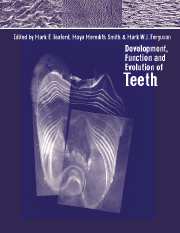Book contents
- Frontmatter
- Contents
- List of contributors
- Acknowledgements
- Part one Genes, molecules and tooth initiation
- Part two Tooth tissues: development and evolution
- Part three Evolution of tooth shape and dentition
- Part four Macrostructure and function
- 16 Developmental plasticity in the dentition of a heterodont polyphyodont fish species
- 17 Enamel microporosity and its functional implications
- 18 Pathways to functional differentiation in mammalian enamel
- 19 Trends in the evolution of molar crown types in ungulate mammals: evidence from the northern hemisphere
- 20 Function of postcanine tooth crown shape in mammals
- 21 Primate dental functional morphology revisited
- Index
19 - Trends in the evolution of molar crown types in ungulate mammals: evidence from the northern hemisphere
Published online by Cambridge University Press: 11 September 2009
- Frontmatter
- Contents
- List of contributors
- Acknowledgements
- Part one Genes, molecules and tooth initiation
- Part two Tooth tissues: development and evolution
- Part three Evolution of tooth shape and dentition
- Part four Macrostructure and function
- 16 Developmental plasticity in the dentition of a heterodont polyphyodont fish species
- 17 Enamel microporosity and its functional implications
- 18 Pathways to functional differentiation in mammalian enamel
- 19 Trends in the evolution of molar crown types in ungulate mammals: evidence from the northern hemisphere
- 20 Function of postcanine tooth crown shape in mammals
- 21 Primate dental functional morphology revisited
- Index
Summary
Food, fossils, form and function
Food is one of the main dimensions of an animal's environment. If we know what animals eat, then we know a great deal about them. If we can infer an animal's food from its anatomy, then we can reconstruct what extinct animals ate. And if we sum this sort of knowledge over the entire fossil record of a group of animals, we might obtain a reasonable idea of what changes, if any, have occurred in the group's ecology. In this way, mammalian paleontology, largely through the study of tooth evolution, has provided a detailed and dynamic picture of the biotic and abiotic changes that have shaped the terrestrial world during the past 65 million years (Archibald, 1983; Janis, 1989, 1993; Janis and Damuth, 1990; Stucky, 1990, 1992, 1995; Maas and Krause, 1994; Gunnell et al., 1995).
Despite this wealth of knowledge, the ties between dental morphology and food remain loose and methods for obtaining more precise information (such as the study of ‘microwear’; see Teaford, 1994; Teaford et al., 1996) are currently far too laborious to be used on entire faunas, guilds, or clades over long intervals. Samples consisting of hundreds of species are required for the study of large-scale patterns of biotal evolution (sensu Van Valen, 1991). For this sort of study, we must identify different ecological groups of mammals – which can, but do not have to be, taxa – rather than phylogenetic lineages. Comparisons of extinct mammalian faunas and their dietary specializations require broadly applicable grouping criteria for teeth.
- Type
- Chapter
- Information
- Development, Function and Evolution of Teeth , pp. 269 - 281Publisher: Cambridge University PressPrint publication year: 2000
- 14
- Cited by



